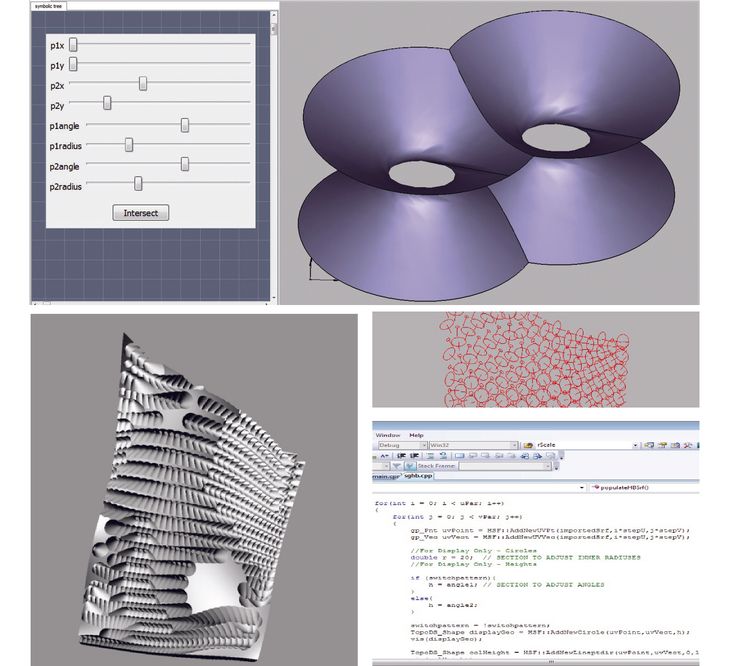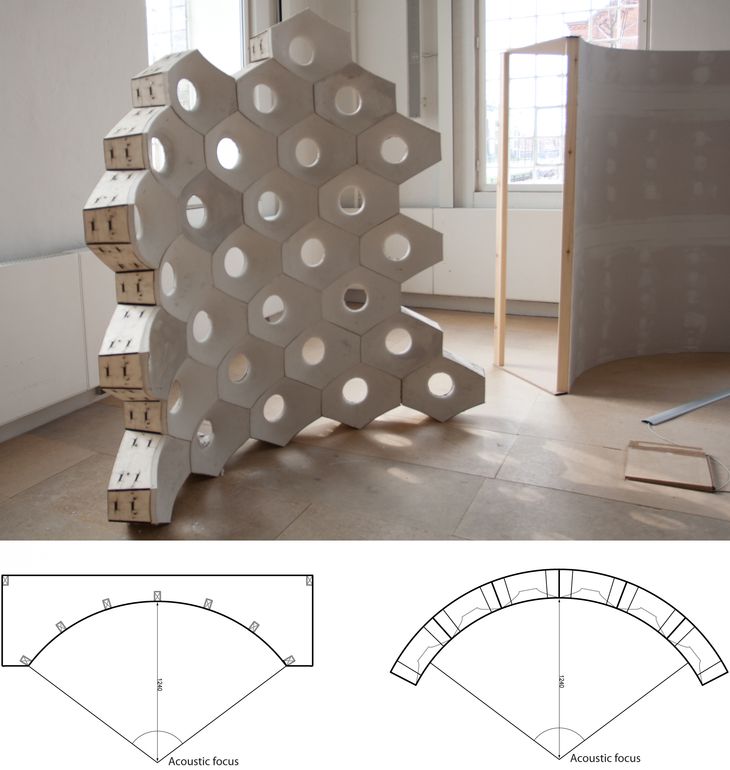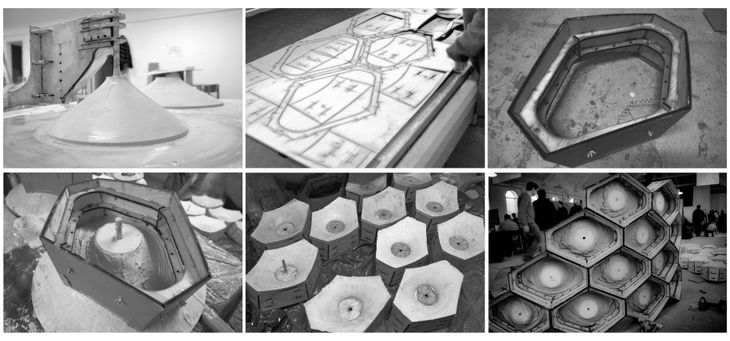Cite as: Burry, Jane, Daniel Davis, Brady Peters, Phil Ayres, John Klein, Alexander Pena de Leon, and Mark Burry. 2011. “Modelling Hyperboloid Sound Scattering: The Challenge of Simulating, Fabricating and Measuring.” In , ed. Christoph Gengnagel, Axel Kilian, Norbert Palz, and Fabian Scheurer, 89–96. Berlin: Springer-Verlag.
Abstract
The Responsive Acoustic Surfaces workshop project described here sought new understandings about the interaction between geometry and sound in the arena of sound scattering. This paper reports on the challenges associated with modelling, simulating, fabricating and measuring this phenomenon using both physical and digital models at three distinct scales. The results suggest hyperboloid geometry, while difficult to fabricate, facilitates sound scattering.
Introduction: The Consecration of the Sagrada Família
The construction of the interior of Gaudí’s Sagrada Família church was completed in 2010. One consequence of the sudden transition of this interior after 126 years, from a site of relentless construction activity to a church, is the first full experience of the acoustics of the space, released from its forests of scaffolding, under the influence of choral, instrumental and clerical presence. Anecdotally, the musicians report the church has a very diffuse acoustic without the long reverberating echoes and islands of intensity characteristic of similar vast volumes constructed from reflective stone surfaces. Just as the effect of the intersecting doubly curved hyperboloid surfaces of the nave walls is to diffuse the light that washes over them, so too it seems the use of the hyperbolic surfaces scatters the sound in an ecclesiastically novel way.

Figure 1 – Sunlight washing over hyperboloids in the Sagrada Família
Building the invisible
In response to the SmartGeometry 2011 design challenge to ‘build the invisible’ we held a workshop - Responsive Acoustic Surfaces - to investigate further this claim that the hyperbolic surfaces of the Sagrada Família were responsible for scattering the sound waves interacting with them, thereby creating a unique and diffuse soundscape within the church. As the hyperbolic surfaces of the Sagrada Familia are constructed from stone, which is a sound reflective material, sound absorption was not considered as part of the design problem and it was determined that sound scattering was the most relevant parameter to study. However, compared to sound absorption and reflection, sound scattering proved to be a most challenging acoustic attribute to simulate and measure.
We planned to do this through acoustic testing of large scale prototype walls configured as fields of subtracted hyperboloids. The experience of the group, in particular Mark Burry, of modelling Gaudí’s architecture for the Sagrada Família church led to a familiarity with the 3D fourth order curves of intersection between neighbouring hyperboloids of revolution of one sheet. The process of fabricating assemblies of these mathematical surfaces, using gypsum plaster, was also known from the approach to the design of the church through the construction of 1:25 and 1:10 plaster models.
The difficulty of understanding the intersections between hyperboloids distributed on a curved wall necessitated, prior to constructing the 1:1 prototype, the production first of digital models and later 1:10 rapid prototyped plaster models. This paper will focus on the design of the various modelling tools, models, simulations and measuring tools developed to produce and test these prototypes, and report on the interim acoustic outcomes.
Digital Modelling

Figure 2 – A sample of the tools used to model hyperboloid intersections
The production of the digital model of the hyperboloid wall, encountered three primary challenges:
- It is computationally expensive to calculate the intersections of multiple hyperboloids, and it is also vital to understand the nature of these intersections.
- The construction logic required planar intersections, which is a constraint not suited to traditional modes of parametric design or optimisation, nor mechanically unassisted manufacturing (traditional construction).
- Prior research suggests that constrained variation produces better sound scattering than homogeny, since it has been seen that the relational depth of surface components and amount of surface detail impact the scattering coefficient. The variation of the depth of surface components introduces different phase characteristics of the reflected sound waves and therefore affects the distribution of the reflected sound pressures. (Peters 2010)
There being no existing software package sufficiently endowed to overcome these challenges, the project combined two existing software with two custom designed tools to model the wall composed of many intersecting hyperboloids. The first custom tool was a C++ scripting environment built on top the open source library Open Cascade to assist in globally propagating hyperboloids across a surface (See Figure 2). The second was a series of custom components for _Grasshopper_™ and _Rhino 3D_™ to automate the modelling of hyperboloids and to simulate the acoustics of various designs.
Through trial and error design explorations we discovered a set of geometric axioms that ensured the intersections between adjacent hyperboloids were always planar provided the hyperboloids were identical. These axioms clashed with the requirement for constrained variation and, since they worked additively, it was difficult to develop a scripted or parametric model that also adhered to a predefined shape. For the acoustic tests it was essential the wall conformed to a particular shape and the final design of the wall was developed with scripts, not axioms, although to simplify the construction of the 1:1 prototype all of the hyperboloids were standardised.
Physical modelling and the 1:1 prototyping

Figure 3 – Hyperboloid wall (left) and flat wall (right), and corresponding plans.
The physical 1:1 construction was conceived of as a single instance or special case of a type of generic output. In early discussion it was posited as a composition derived from discrete sub-units or bricks making up a finite number of geometrical variants in order to be able to model and test a variety of differently composed surfaces. In the weeks leading up to the fabrication and testing - during which the techniques, equipment and knowledge were developed to be able to fabricate the plaster bricks successfully - it became clear that fabricating a family of different ‘brick’ components would not be feasible within our four day construction window. Instead a single hyperboloid brick was designed such that in multiples they could be stacked together to form a semi cylindrical section. A similarly sized companion wall was constructed from smooth plaster and uses as the control during the sound tests. The overall geometry of both was a semi cylindrical section, chosen because sound originating from the acoustic focus is reflected back to the source, making any change in the reflected sound between the two immediately perceivable by someone standing in the cylinder centre.

Figure 4 – Top: The hyperboloid mould, laser cutting of hexagonal frame, the frame. Bottom: Hexagonal frame on mould, selection of bricks, assembled wall from behind.
Using the same process employed by the Sagrada Família model makers, the hyperboloid of the bricks was shaped as negative plaster moulds by revolving a plasma-cut stainless steel hyperbolic profile about an axis. On top of these plaster master moulds, a hexagonal plywood box was placed, which served a duel purpose as the structure of the brick and as the formwork defining the edge of the brick when the plaster positive was poured. The plaster poured into these hexagonal boxes dried in around 30 minutes, at which point the brick, together with its plywood frame, could be released from the negative.
Since the construction method produced bricks with planar edges, the point where two bricks adjoin - the intersection between hyperboloids - had to be contrived to be planar as well. As was previously discussed, the axioms to ensure the intersections were planer conflicted with the acoustic requirement that the wall be made from a cylindrical section. To meet this requirement, the hyperboloids were propagated across the semi cylindrical wall resulting in an intersection curve that slightly deviated from being planar. This 4mm discrepancy was absorbed by the slight flexibility of the plywood frame when bolted together.
Sound behaviour

Figure 5 – Graph of scattering coefficient with respect to frequency, and corresponding 1:10 plaster model.
Sound scattering is typically measured through the scattering coefficient, which is defined as the amount of sound energy scattered away from the specular reflection direction by a rough surface. (Vorlander and Mommertz 2000) This coefficient is frequency dependent and there is a relationship between the geometry and the scattering coefficient at different frequencies. (Peters 2010) During the workshop, participants developed digital models of hyperbolic geometry from which 1:10 scale rapid prototypes were made and then tested in controlled conditions for their scattering characteristics (See Figure 5). (ISO 2004) The use of both scripting and rapid prototyping in developing these models assisted in quickly iterating designs in response to immediate results all within the four day duration of the workshop.
The sound scattering coefficients are necessary to make reliable simulations and predictions of acoustic performance (Christensen and Rindel 2005) While the ISO standard suggests using physical measurement to determine scattering coefficients, it has been suggested that finite different techniques could be used to calculate these virtually. (Redondo et al. 2009) A digital tool was developed using a similar finite difference time domain (FDTD) algorithm, to simulate and visualize the interaction of sound waves with the hyperboloid components (See Figure 6). These visualizations demonstrate that the depth of the hyperboloid assists in spreading out the reflected sound wave, so the peaks and troughs are less pronounced. This is a promising first step in the digital simulation of sound scattering but more work is needed to derive the scattering coefficient and to calculate the impulse response.
There are pronounced acoustic differences between the smooth 1:1 wall and the 1:1 wall made of hyperboloids. Standing in the acoustic focus of the smooth 1:1 wall and speaking generates a discernible echo, which is seemingly amplified because the cylindrical geometry concentrates the reflected sound back to the focus point. In contrast, speaking from the same spot in front of the 1:1 wall made of hyperboloids produces no audible echo, since the incident sound is reflected by the hyperboloid geometry in many directions and only a portion of the sound returns to the focus point. These perceptual experiences conform to the acoustic measurements of the 1:10 prototypes, and the visualisations of sound scattering using finite difference techniques.

Figure 6 – FDTD Visualization of Scattering from smooth wall compared to hyperboloid wall
Conclusions
The Responsive Acoustic Surfaces workshop at SmartGeometry 2011 brought together a wide variety of simulation, fabrication and measuring techniques to analyse the relationship between hyperboloids and sound scattering. In producing architecture that performs acoustically, it is necessary that the performance is measureable, and that there is some sort of feedback system that allows designs to be evaluated. In this case the sound scattering performance was evaluated by both physical models and by sound wave visualizations. Both techniques need development, but point to a method to integrate sound performance in parametric architectural tools.
The interim results of the acoustic test demonstrate that the geometry of hyperboloids have a perceptual influence on sound scattering, perhaps accounting for the diffuse acoustic of the Sagrada Família. However the challenges inherit with hyperboloid geometry makes them, at this point in time, impractical sound scattering devices – despite this study’s novel innovations in the design, modelling and fabrication of hyperboloids. It is anticipated that future work will identify geometry with similar acoustic properties to hyperboloids, which are more amenable to modern construction techniques.
Acknowledgements
The authors are grateful for the support of: SmartGeometry and the Centre for Information Technology and Architecture (CITA) in facilitating this research; Tobias Olesen, Peter Holmes and Annica Ekdahl for their assistance in running the workshop; and the workshop participants: Adam Laskowitz, Ben Coorey, Eric Turkiemicz, Giovanni Betti, Kathy Yuen, Ralf Lindemann, Robin Bentley and Thomas Hay.
References
Brady P, Tobias O (2010) Integrating Sound Scattering Measurements in the Design of Complex Architectural Surfaces: Informing a parametric design strategy with acoustic measurements from rapid prototype scale models. 28th eCAADe Conference Proceedings, Zurich.
Christensen CL, Rindel JH (2005) A new scattering method that combines roughness and diffraction effects. Forum Acusticum, Budapest.
ISO 2004, Acoustics - Sound-scattering properties of surfaces -. Part 1: Measurement of the random-incidence scattering coefficient in a reverberation room, ISO, Geneva.
Redondo J, Picó R, Avis M, Cox T (2009) Prediction of the Random-Incidence Scattering Coefficient Using a FDTD Scheme. Acta Acustica United with Acustica 95:1040 – 1047.
Vorlander M, Mommertz E (2000) Definition and measurement of random-incidence scattering coefficients. Applied Acoustics 60:187-199.